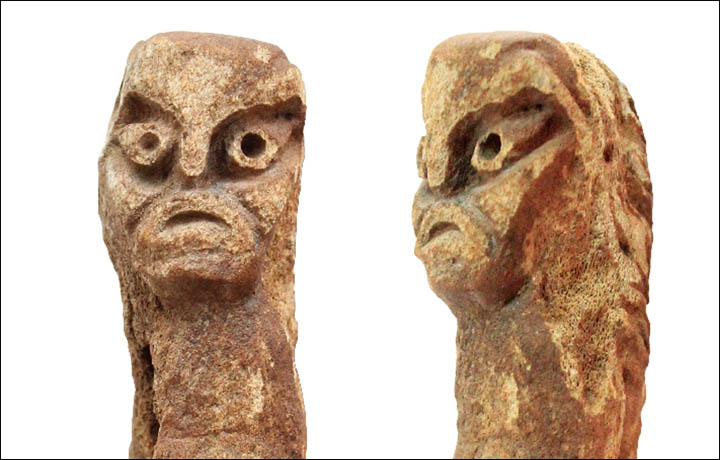“It is true miracle that Nikolay Tarasov found it…It is one of the most significant archaeological exhibit in our collection. It is on display now and we welcome people to come to us and see it.” – Ekaterina Vambrikova, Museum Guide.

PHOTO: siberiantimes.com
TISUL, SIBERIA – A fisherman was going about his daily business, fishing along the Dudet River near his home when he wound up catching something much more valuable than tench and carp.
“I was about to throw it back in the water – but at the last second I looked at it more closely,” the fisherman, Nikolay Tarasov, told the Siberian Times, “And I saw a face. I stopped and washed the thing in the river – and realised it wasn’t a stone of an unusual shape, as I thought earlier – but a statuette.”
He had caught a fossilized figurine made from animal bone carved with a set of almond-shaped eyes, a down-turned mouth, and a vengeful expression. The figure is depicted with plaited hair, too. As soon as he realized what it was, he took it to the experts at a local museum, who he said ‘literally jumped for joy’.
Dr. Pavel German, an expert at the Institute of Human Ecology in Kemerovo, said he believed the figurine to be unique among Siberian archaeology.
“It is interesting that the face depicted on this figurine has a very distinctive expression of ferocity and rage. Usually the ancient – Neolithic and Bronze Age – anthropomorphic sculptures do not have any distinctive expression.” – Dr. German
Experts have matched the carving style of the figurine to the local Okunev culture, a Bronze Age people group that dates to the 2nd millennium BC, and lived in southern Siberia. They made their living by raising cattle, sheep, and goats, supplemented by hunting and fishing. So far, archaeologists have found no indication that the Okunev people had a concept of “owning” land, or had any sort of social stratification.
The archaeologists have been trying to work out how such an object would have gotten into the water to be scooped up by the fisherman. “The find could got into the water due to different circumstances, among them – the destruction of an ancient child’s burial. The figurine was found in a local river,” Dr. German explained, “and we went to the site, hoping there would be more [archaeological evidence], but sadly we had no luck.”
But, what was the figurine for? Why did it need such a ferocious expression carved into it? Was it simply a toy or a decoration, or something more? Another Okunev site may give researchers a clue.
A Sign of Protection
There’s been a similar find made at a site 300 miles northwest of where Nikolay Tarasov found the figurine in the river. Buried in the waters of Lake Itkol, at a site called Khakassia, archaeologists have found eight figurines carved from animal horn. They were buried with the remains of several babies from the Okunev culture. Experts have been comparing the figurines to modern-day baby rattles.
![The baby burial at Itkol Lake [PHOTO: siberiantimes.com]](https://historythings.com/wp-content/uploads/2016/09/inside_itkol_gv.jpg)
The baby burial at Itkol Lake [PHOTO: siberiantimes.com]
The figurines from Lake Itkol also have ferocious faces carved into them. The experts handling the find believe they were made to ward off evil spirits.
Dr. German said, “Our figurine shows a resemblance to those found in child burials at Itkol Lake. When we undertook our research we did not know about the Itkol figurines.”
There’s more to the story, too.
“There is a hole drilled in the figurine,” Dr. German explained, “We found a small wooden stick, a twig, inside it.”
The experts have a theory that the figurine originally was attached to a baby’s cot. Eventually, the twig snapped, and the figurine fell with some of the branch still inside of it.
Another feature that lends itself to speculation is the etching of something that resembles fish or snake scales in the animal bone. Both fish and snakes are tied to the Okunev idea of the afterlife. Perhaps, when the figurine could not guard its small charge in life, its parents hoped that it would guide their child safely to the underworld after death.

